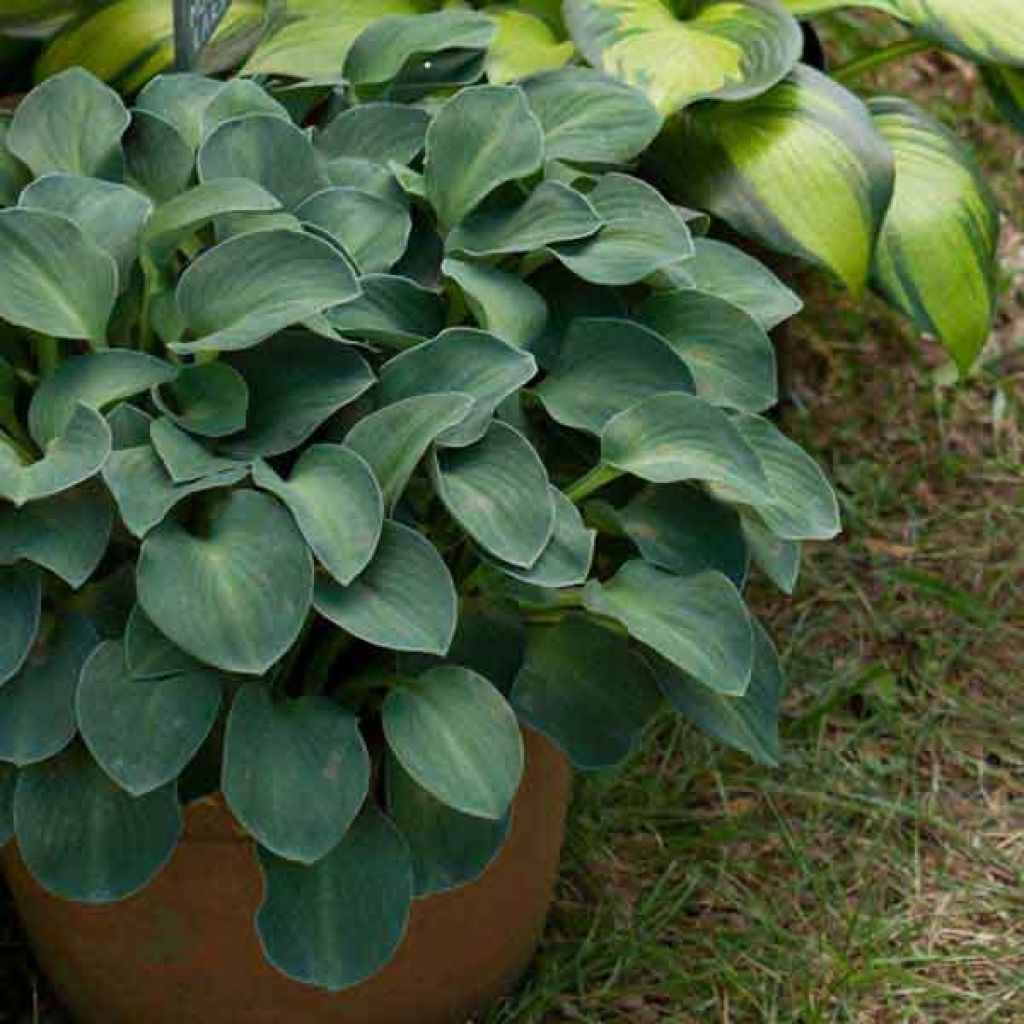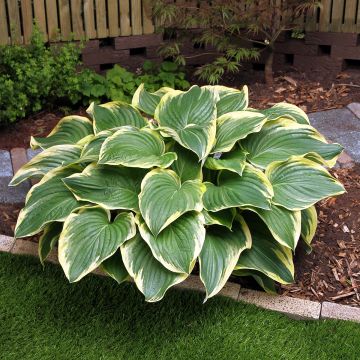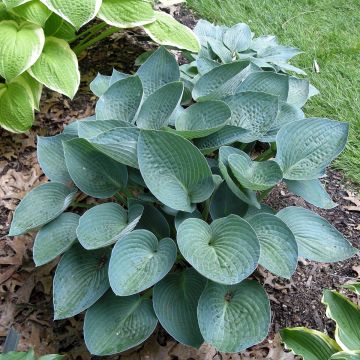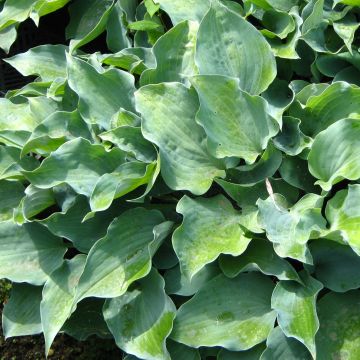

Hosta Blue Mouse Ears


Hosta Blue Mouse Ears


Hosta Blue Mouse Ears


Hosta Blue Mouse Ears


Hosta Blue Mouse Ears
Hosta Blue Mouse Ears
Hosta Blue Mouse Ears
Plantain Lily, Funkia
3 petites necks of mouse Received in very good condition more than a month ago. The recovery has been very good, they have grown and flourished at the foot of an old climbing rose colonized by a clematis. They receive soil in the morning and it seems to suit them well, too bad I can't post a photo.
Martine Wojcicki , 01/05/2023
Special offer!
Receive a €20 voucher for any order over €90 (excluding delivery costs, credit notes, and plastic-free options)!
1- Add your favorite plants to your cart.
2- Once you have reached €90, confirm your order (you can even choose the delivery date!).
3- As soon as your order is shipped, you will receive an email containing your voucher code, valid for 3 months (90 days).
Your voucher is unique and can only be used once, for any order with a minimum value of €20, excluding delivery costs.
Can be combined with other current offers, non-divisible and non-refundable.
Home or relay delivery (depending on size and destination)
Schedule delivery date,
and select date in basket
This plant carries a 12 months recovery warranty
More information
We guarantee the quality of our plants for a full growing cycle, and will replace at our expense any plant that fails to recover under normal climatic and planting conditions.


Would this plant suit my garden?
Set up your Plantfit profile →
Description
The Hosta 'Blue Mouse Ears', also known as Funkia 'Blue Mouse Ears', is an adorable miniature variety with thick blue-grey foliage, each curved and pointed leaf resembling a mouse ear in shape and texture. This compact plant proves to be very sturdy and forms a neat, dense mound that is covered in lavender flower spikes during the summer. Resistant to snails and slugs, this variety makes beautiful borders or can be used as a delightful ground cover when planted en masse in cool shade. It also thrives in pots.
The Hosta 'Blue Mouse Ears' is a deciduous perennial plant belonging to the hosta family, or lily family according to classical classification. From spring onwards, it forms small circular clumps that almost spread like a carpet, with symmetrical growth. This is one of the many hybrids created from the hybridization of the variety 'Blue Cadet', itself descended from species native to Japan and China. The plant reaches a height of 10 to 20 cm (4 to 8in) for the foliage and spreads over 30 to 50 cm (12 to 20in). It has heart-shaped leaves with smooth and very thick laminae, pruinose blue-grey in colour with a fine white border. The leaves have a curious appearance, resembling mouse ears with their curled edges and pointed tips. The plant retains its blue colouration well in slightly sunny positions. Pale green flower spikes rise above the foliage and display large bell-shaped flowers in July-August, relative to the size of the plant. The flowers are pale lavender and borne in fairly compact clusters. This perennial spreads by stolons, similar to strawberries.
The Hosta 'Blue Mouse Ears' pairs well with helxine, alchemilla, ferns, and eucomis in partial shade, creating an elegant and surprising effect that requires minimal maintenance. This dwarf hosta also thrives in borders, cool and shaded rockeries, alongside columbines and bleeding hearts, or even with small violets. All hostas grow well in pots and can remain in the same container for several years. Choose a special geranium potting mix to use during the growing season. As long as the foliage is not too dense, watering from the top of the pot is sufficient. Then place a saucer under the pot and pour water into it, keeping the level constant in summer.
Report an error about the product description
Hosta Blue Mouse Ears in pictures






Flowering
Foliage
Plant habit
Botanical data
Hosta
Blue Mouse Ears
Liliaceae - Hostaceae
Plantain Lily, Funkia
Cultivar or hybrid
Other Hostas - Plantain Lilies
View all →Planting and care
Hostas are planted in spring or autumn. Hostas thrive in a deep, rich, humus-bearing, loose soil, preferably neutral to acidic (at least low in limestone), and moist to wet throughout the year. Plant them in partial or dappled shade, and in a sheltered location away from strong winds.
Prepare a planting hole of 20 cm (8in) x 20 cm (8in) x 20 cm (8in). If your soil is heavy, mix equal parts of compost with crumbled soil, partially backfill the hole, and place your potted plant in such a way that the top of the root ball is covered with 3 cm (1in) of soil. Applying a slow-release fertiliser (dehydrated blood, horn powder) will nourish your plant during its rooting period without the risk of burning. Make sure to position the collar well above the soil level. Firm the soil and water generously to eliminate air pockets. If the weather is dry, regular watering for a few weeks is necessary to facilitate the establishment of your plant. Also, water regularly during dry summers.
With their shared preference for moist locations, slugs and snails are never far away from hostas. Even though blue or variegated hostas often have thicker and tougher foliage, which is less appealing to slugs, these plants still need protection against gastropods. Protect your hosta plants by surrounding them with ferramol-based granules (approved for organic farming), eggshells, coffee grounds, mulch, or any dry and rough natural substance that repels them. Hedgehogs are the gardener's best allies in the fight against gastropods because, unlike chickens, they do not till the soil or attack the tender green shoots of young plants. Finally, some plants have a repulsive smell for slugs, such as wormwood and garlic.
Planting period
Intended location
Care
-
, onOrder confirmed
Reply from on Promesse de fleurs
Haven't found what you were looking for?
Hardiness is the lowest winter temperature a plant can endure without suffering serious damage or even dying. However, hardiness is affected by location (a sheltered area, such as a patio), protection (winter cover) and soil type (hardiness is improved by well-drained soil).

Photo Sharing Terms & Conditions
In order to encourage gardeners to interact and share their experiences, Promesse de fleurs offers various media enabling content to be uploaded onto its Site - in particular via the ‘Photo sharing’ module.
The User agrees to refrain from:
- Posting any content that is illegal, prejudicial, insulting, racist, inciteful to hatred, revisionist, contrary to public decency, that infringes on privacy or on the privacy rights of third parties, in particular the publicity rights of persons and goods, intellectual property rights, or the right to privacy.
- Submitting content on behalf of a third party;
- Impersonate the identity of a third party and/or publish any personal information about a third party;
In general, the User undertakes to refrain from any unethical behaviour.
All Content (in particular text, comments, files, images, photos, videos, creative works, etc.), which may be subject to property or intellectual property rights, image or other private rights, shall remain the property of the User, subject to the limited rights granted by the terms of the licence granted by Promesse de fleurs as stated below. Users are at liberty to publish or not to publish such Content on the Site, notably via the ‘Photo Sharing’ facility, and accept that this Content shall be made public and freely accessible, notably on the Internet.
Users further acknowledge, undertake to have ,and guarantee that they hold all necessary rights and permissions to publish such material on the Site, in particular with regard to the legislation in force pertaining to any privacy, property, intellectual property, image, or contractual rights, or rights of any other nature. By publishing such Content on the Site, Users acknowledge accepting full liability as publishers of the Content within the meaning of the law, and grant Promesse de fleurs, free of charge, an inclusive, worldwide licence for the said Content for the entire duration of its publication, including all reproduction, representation, up/downloading, displaying, performing, transmission, and storage rights.
Users also grant permission for their name to be linked to the Content and accept that this link may not always be made available.
By engaging in posting material, Users consent to their Content becoming automatically accessible on the Internet, in particular on other sites and/or blogs and/or web pages of the Promesse de fleurs site, including in particular social pages and the Promesse de fleurs catalogue.
Users may secure the removal of entrusted content free of charge by issuing a simple request via our contact form.
The flowering period indicated on our website applies to countries and regions located in USDA zone 8 (France, the United Kingdom, Ireland, the Netherlands, etc.)
It will vary according to where you live:
- In zones 9 to 10 (Italy, Spain, Greece, etc.), flowering will occur about 2 to 4 weeks earlier.
- In zones 6 to 7 (Germany, Poland, Slovenia, and lower mountainous regions), flowering will be delayed by 2 to 3 weeks.
- In zone 5 (Central Europe, Scandinavia), blooming will be delayed by 3 to 5 weeks.
In temperate climates, pruning of spring-flowering shrubs (forsythia, spireas, etc.) should be done just after flowering.
Pruning of summer-flowering shrubs (Indian Lilac, Perovskia, etc.) can be done in winter or spring.
In cold regions as well as with frost-sensitive plants, avoid pruning too early when severe frosts may still occur.
The planting period indicated on our website applies to countries and regions located in USDA zone 8 (France, United Kingdom, Ireland, Netherlands).
It will vary according to where you live:
- In Mediterranean zones (Marseille, Madrid, Milan, etc.), autumn and winter are the best planting periods.
- In continental zones (Strasbourg, Munich, Vienna, etc.), delay planting by 2 to 3 weeks in spring and bring it forward by 2 to 4 weeks in autumn.
- In mountainous regions (the Alps, Pyrenees, Carpathians, etc.), it is best to plant in late spring (May-June) or late summer (August-September).
The harvesting period indicated on our website applies to countries and regions in USDA zone 8 (France, England, Ireland, the Netherlands).
In colder areas (Scandinavia, Poland, Austria...) fruit and vegetable harvests are likely to be delayed by 3-4 weeks.
In warmer areas (Italy, Spain, Greece, etc.), harvesting will probably take place earlier, depending on weather conditions.
The sowing periods indicated on our website apply to countries and regions within USDA Zone 8 (France, UK, Ireland, Netherlands).
In colder areas (Scandinavia, Poland, Austria...), delay any outdoor sowing by 3-4 weeks, or sow under glass.
In warmer climes (Italy, Spain, Greece, etc.), bring outdoor sowing forward by a few weeks.











































